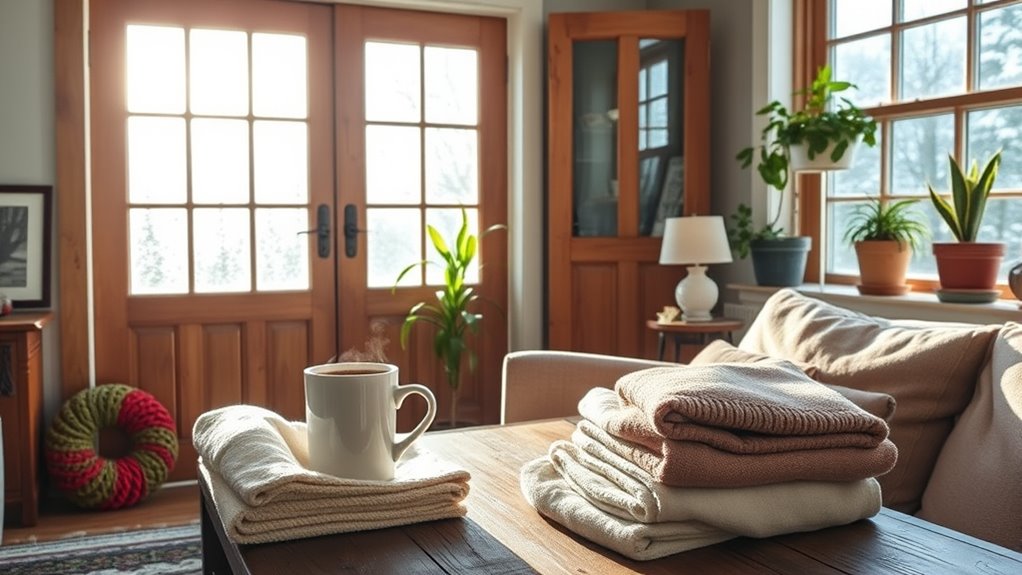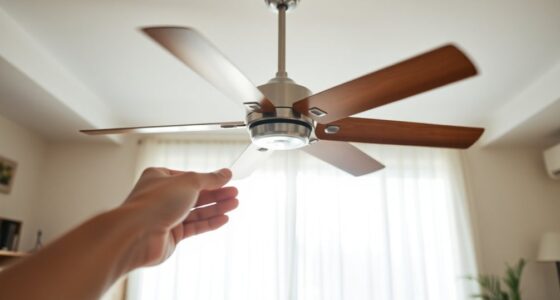To winterize your home on a budget, start by sealing drafts around windows and doors with caulk or weatherstripping. Insulate your attic and use budget-friendly options like fiberglass or cellulose. Improve heating efficiency by maintaining your system and adjusting thermostat settings. Implement modifications like heavy curtains or smart home devices, and prepare your exterior by clearing gutters and insulating pipes. Finally, stay informed about local weather and emergencies. You can find even more tips to enhance your winterization efforts.
Key Takeaways
- Seal drafts with caulk or weatherstripping around windows and doors to retain warmth and reduce heating costs.
- Insulate pipes and exterior walls with budget-friendly materials like fiberglass batt or foam sleeves to prevent freezing.
- Hang heavy thermal curtains to improve insulation and reduce heat loss through windows.
- Regularly maintain your heating system by checking filters and conducting an energy audit to enhance efficiency.
- Use LED bulbs and smart devices to lower energy consumption and monitor heating costs effectively.
Seal Drafts and Caulk Gaps
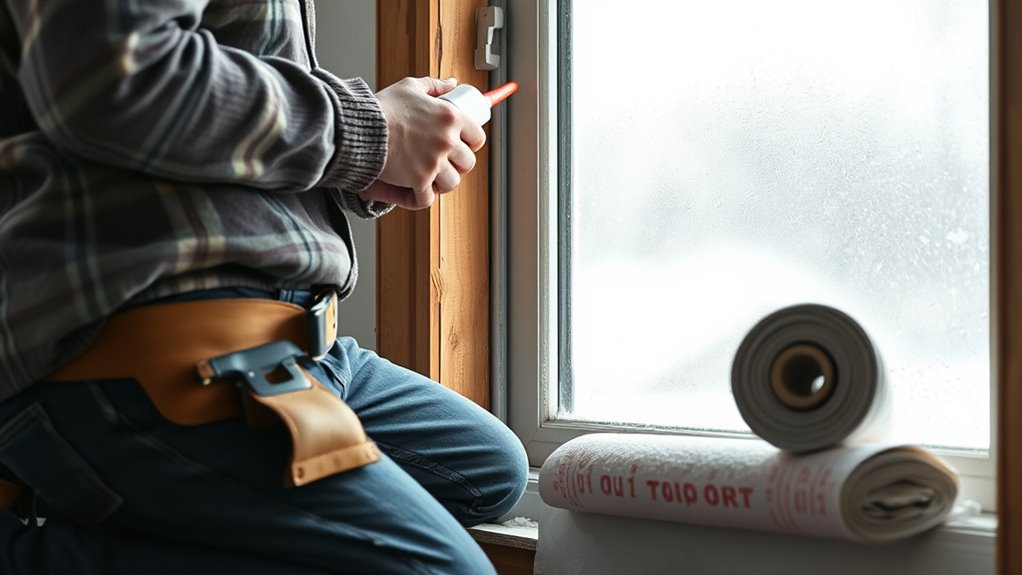
As winter approaches, sealing drafts and caulking gaps becomes essential to keep your home warm and energy-efficient.
Start by identifying potential draft sources, like gaps around windows, doors, and utility entries. You can visually inspect for dirty spots on walls or ceilings, which may indicate air leaks. Feel for drafts by hand, or consider a professional thermal imaging assessment for accuracy. Additionally, be aware that wood-burning can contribute to air pollution, which may lead to respiratory issues if your home is not properly sealed. Proper sealing can enhance the efficiency of your geothermal heat pump system, which utilizes the Earth’s stable temperature for heating and cooling. Furthermore, minimizing drafts can prevent your system from experiencing mechanical failures due to excessive workload. Effective sealing can also lead to improved air quality in your home by reducing the infiltration of outdoor pollutants.
Once you’ve pinpointed the gaps, gather your caulk and caulk gun. Clean the areas, remove old caulk, and apply a fresh bead in stationary spots.
Choose the right type of caulk based on location, and remember to check and reapply as needed. These simple steps will greatly improve your home’s comfort and help you save on heating bills. Additionally, improving insulation and sealing drafts can enhance the efficiency of your heat pump system, resulting in lower energy costs throughout the winter months.
Insulate the Attic
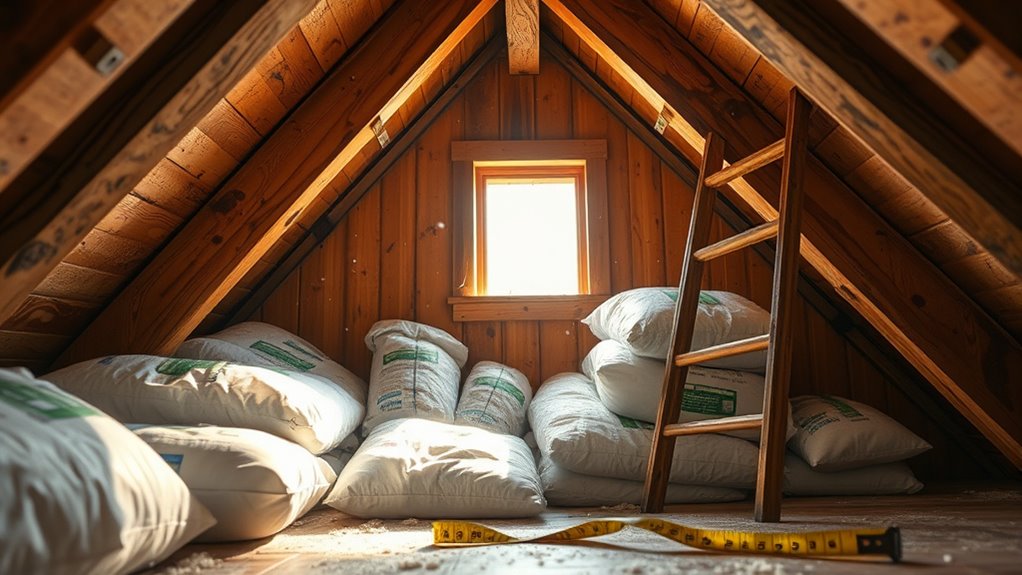
After sealing drafts and caulking gaps, the next step to winterizing your home on a budget is insulating the attic.
You have several budget-friendly options, like fiberglass batt and roll or loose-fill cellulose, which are both effective and easy to install. Effective co-parenting communication can also help ensure that any home improvements benefit the overall family environment. Additionally, proper insulation can aid in maintaining hydration and nutrition levels in your home by regulating temperature and reducing heating costs. Installing insulation can also reduce heating costs by as much as 30% or more over time. Using insulation techniques similar to those employed in airless paint sprayers can lead to better performance and efficiency.
Fiberglass loose-fill and mineral wool also resist moisture and pests. Consider blown-in insulation for even coverage, but be aware it requires specialized equipment.
Fiberglass loose-fill and mineral wool provide moisture and pest resistance, while blown-in insulation ensures even coverage with specialized equipment.
For a DIY project, you can save money by installing insulation yourself or using recycled materials. Aim for a thickness of five to six inches for ideal performance. Additionally, ensure your attic is well-ventilated to prevent moisture buildup that can lead to mold growth.
Improve Heating Efficiency

To improve heating efficiency in your home, start by maintaining your heating system and addressing any issues that could lead to energy waste. Regularly check and replace dirty filters, and inspect for leaks.
Conducting an energy audit can help you identify areas where heat escapes, guiding effective improvements. If you have a heat pump, make certain it’s well-maintained; a neglected one can use up to 25% more fuel. Additionally, you might consider consulting an expert about required minimum distributions to ensure that any potential tax impacts are accounted for when investing in upgrades.
Adjust your thermostat settings, especially when the home is unoccupied, to save energy. Finally, consider upgrading to energy-efficient heating systems, which may qualify for rebates or tax credits. Additionally, being aware of state tax implications for energy-efficient upgrades can further enhance your overall savings.
These steps won’t only enhance your home’s warmth but also reduce your energy bills this winter.
Implement Budget-Friendly Modifications
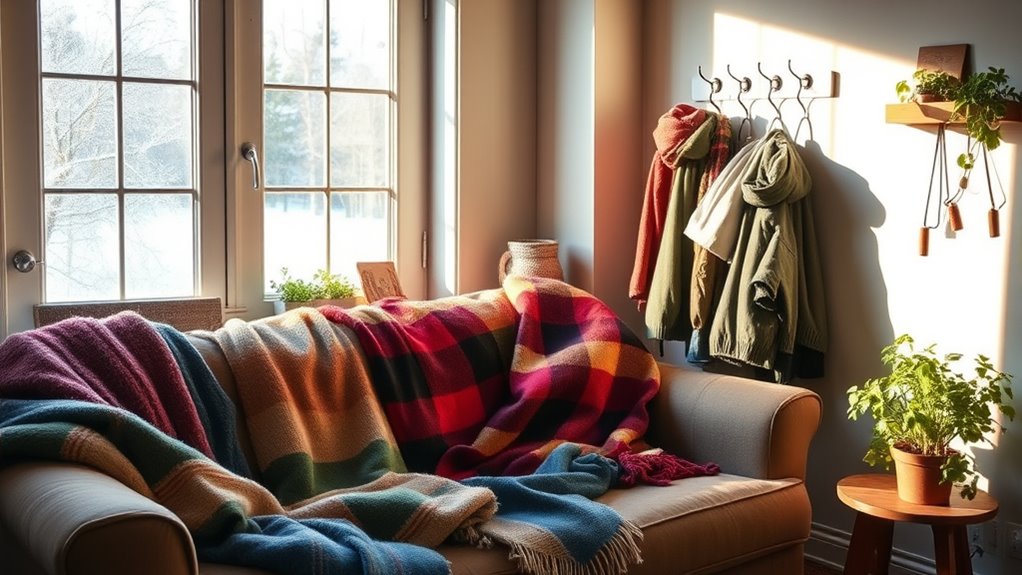
Implementing budget-friendly modifications can considerably enhance your home’s winter readiness without breaking the bank.
Start by sealing drafts using rolled-up towels or homemade draft stoppers made from old socks. Apply weatherstripping or caulk to close gaps around your windows and doors. For added insulation, hang heavy sheets or thermal curtains over windows. Additionally, using smart home devices can help monitor and control your heating efficiently. Consider incorporating natural materials in your home decor, as they can also provide insulation benefits. Regularly checking your air purifier filters can also help maintain indoor air quality during the winter months. To further improve your home’s efficiency, consider adding a backyard greenhouse to extend your growing season and reduce reliance on store-bought produce.
In your attic, consider adding fiberglass insulation to retain warmth effectively. Don’t forget your ceiling fan; reversing its direction can push warm air down.
Additionally, consider the benefits of Leave No Trace principles which can guide you in maintaining a sustainable home environment during winter. Finally, verify your smoke detectors and dryer vents are clean and functional, helping to maintain efficiency and safety. These simple steps can make a significant difference in your home’s comfort this winter.
Prepare Your Exterior
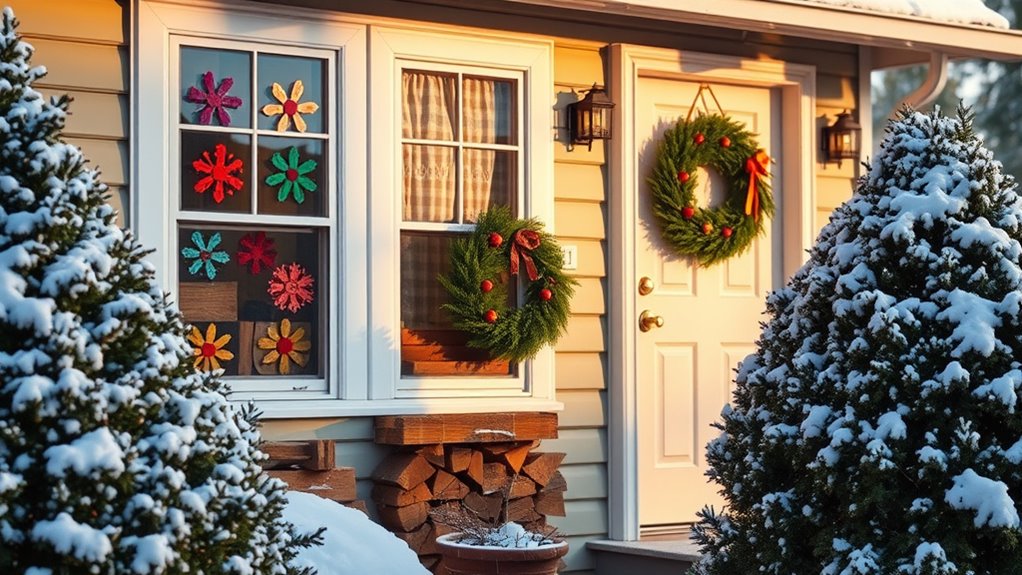
As winter approaches, preparing your home’s exterior is essential to guarantee it can withstand harsh weather conditions.
Start by insulating your exterior walls and siding to reduce heat loss, especially in older homes. Don’t forget your exterior doors; draft guards can help keep warm air inside. Seal gaps around windows and doors with caulk to maintain warmth. Additionally, consider the potential for energy efficiency improvements that can significantly lower heating costs during the winter months. Installing a modern heat pump can also enhance your home’s efficiency and reduce heating expenses, as heat pumps can achieve efficiencies of 300-600% compared to traditional systems. Regular maintenance of your heat pump system can further optimize its performance during colder months.
Next, clear your gutters and downspouts to prevent ice buildup and make certain proper water flow.
Regularly remove snow from your roof and pathways to avoid structural damage and accidents. Cover outdoor furniture to protect it from the elements, and be sure to disconnect and drain hoses to prevent freezing. Additionally, consider conducting a home energy audit to identify further areas for improvement in your home’s energy efficiency.
Taking these steps will help you winterize your home effectively and affordably.
Protect Against Water Damage
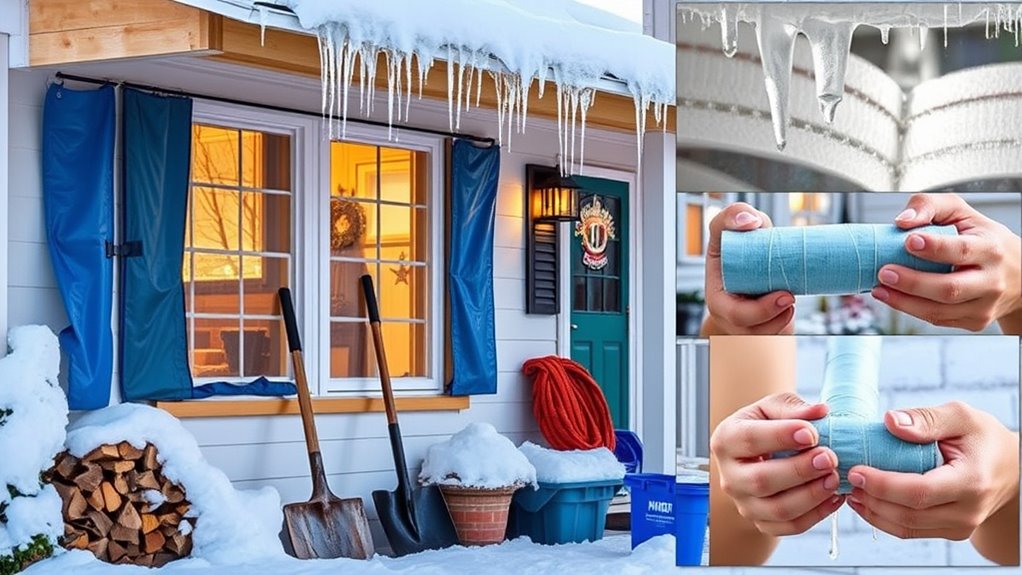
While winter can bring beautiful scenery, it also poses significant risks of water damage to your home if you’re not prepared. To protect against this, start by turning off your main water valve and draining the system by opening faucets and flushing toilets.
Winter’s beauty can hide serious risks; prepare your home by turning off the main water valve and draining the system.
Use antifreeze in drains to prevent freezing. Insulate your pipes with foam sleeves and consider heat tape for unheated areas; this will help maintain optimal water flow throughout your plumbing system. Seal any cold air entry points around windows and doors to keep warmth in.
Don’t forget to disconnect and drain garden hoses and outdoor faucets. Letting faucets drip overnight can help maintain water movement, reducing the risk of freezing. Additionally, ensure you have essential safety equipment like a carbon monoxide detector in place to monitor for gas leaks that can occur during winter heating.
Regularly check for leaks to catch issues early and prevent costly damages.
Conduct Seasonal Maintenance

To guarantee your home withstands the winter months without costly issues, conducting seasonal maintenance is essential.
Start by inspecting and cleaning your gutters and downspouts to confirm proper water flow and prevent ice dams. Seal any entry points around windows and doors with weatherstripping and caulk to keep the cold air out.
Don’t forget to cover your AC units and drain outdoor faucets to avoid freezing. For your HVAC system, clean filters and check thermostat settings for efficiency.
Additionally, inspect your roof for damage, and look for signs of leaks in walls and ceilings. Taking these steps now will save you from bigger headaches when winter hits.
Utilize Energy-Efficient Lighting
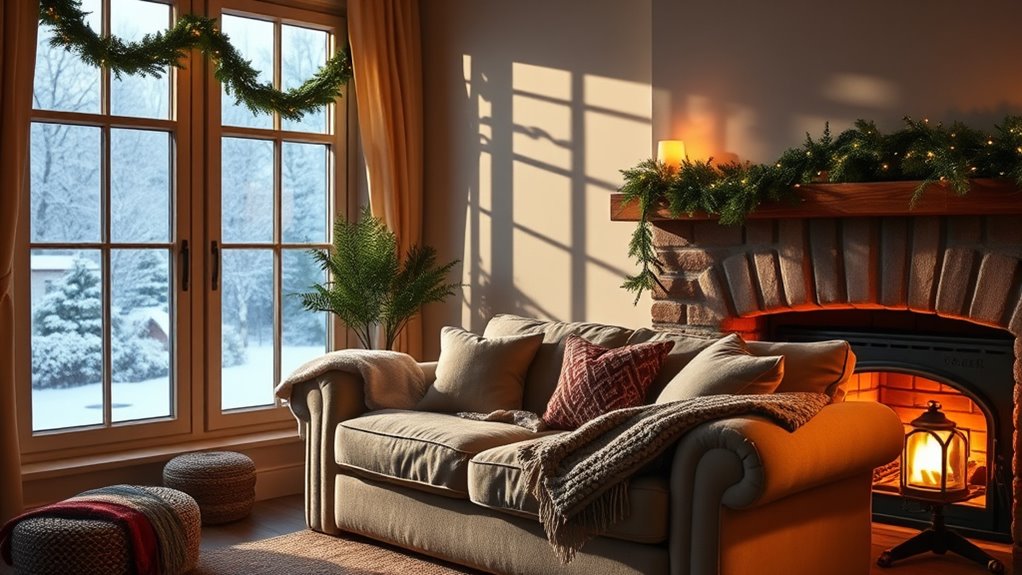
After conducting seasonal maintenance to prepare your home for winter, it’s time to contemplate how energy-efficient lighting can enhance your comfort and savings during the colder months.
Switching to LED bulbs is a smart choice; they consume less energy and can last up to 25 times longer than traditional bulbs. Though they may have a higher upfront cost, you’ll notice reduced energy bills over time. Look for ENERGY STAR certified options to guarantee efficiency.
Switching to LED bulbs saves energy and lasts longer, leading to reduced bills over time. Look for ENERGY STAR certified options.
Don’t forget about your holiday lighting—opting for energy-efficient LED lights can save you up to 75% on energy. Consider adding dimmers or motion sensors to further cut down on energy use.
These simple changes can make your home cozier while saving you money.
Stay Informed and Plan for Emergencies
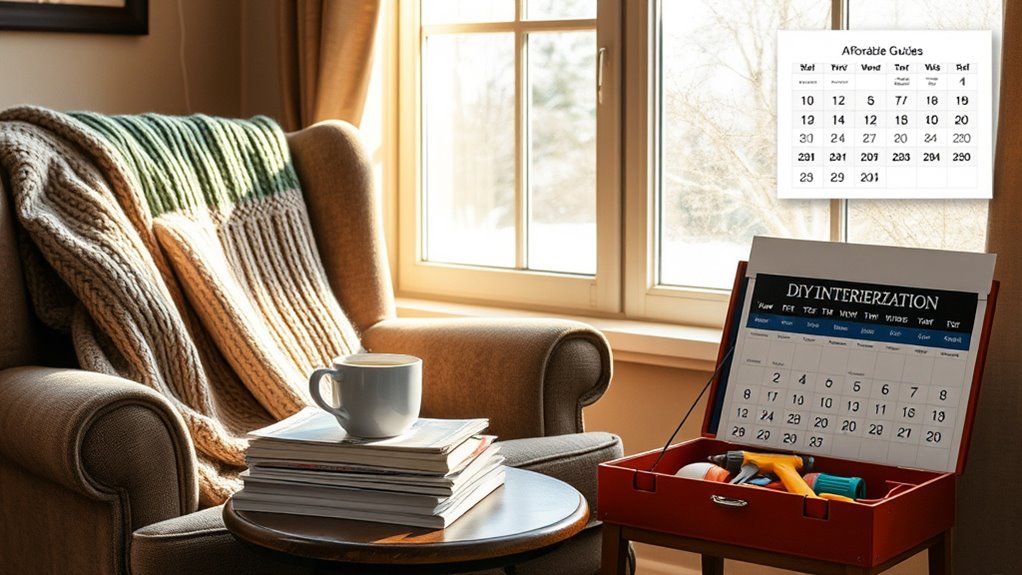
As winter approaches, staying informed about potential hazards and planning for emergencies is essential to keep your home and family safe. Start by gathering information on local weather patterns and signing up for emergency alerts. Keep a list of emergency contacts handy and familiarize yourself with local services.
Create an emergency plan that includes evacuation routes and shelter options. Build a disaster supplies kit with food, water, and first aid items. Organize important documents and set aside emergency funds for unexpected expenses.
Assess your home’s vulnerabilities by checking the roof, insulating pipes, and weatherproofing windows. Finally, prepare for power outages with flashlights and alternative heating sources to guarantee your family stays safe and comfortable this winter.
Frequently Asked Questions
How Can I Tell if My Insulation Needs Replacing?
To tell if your insulation needs replacing, look for signs like moisture damage, fire damage, or rodent infestations.
If you notice higher energy bills, inconsistent temperatures, or drafts, your insulation mightn’t be effective anymore.
Also, check for physical signs like settled or wet insulation and excessive dust accumulation.
If your insulation is old, especially in homes built before 2005, it may not meet current standards and should be replaced.
What Are the Best Materials for Weatherstripping?
When you’re choosing materials for weatherstripping, consider your needs.
Felt is budget-friendly but has a short lifespan. For durability, go with rubber; it’s flexible and long-lasting.
If you need versatility, vinyl foam tape works indoors and outdoors. For gaps, open-cell foam with adhesive backing is great.
If you want a sealed fit, try V strips. Always install when it’s warm, and check your materials regularly for wear!
How Often Should I Check My Smoke Detectors in Winter?
You should check your smoke detectors at least once a month during winter.
Cold temperatures can impact their performance, so testing them frequently helps guarantee they’re ready in emergencies.
Additionally, remember to change the batteries every six months and clean the sensors to prevent dust buildup.
After any power outages, test them immediately to confirm they’re working.
Regular checks assure your safety and keep false alarms to a minimum.
Can I Winterize My Home Myself or Hire a Professional?
You can definitely winterize your home yourself or hire a professional, depending on your comfort level and budget.
If you’re handy, DIY can save you money and give you a sense of accomplishment. However, if you lack experience, hiring a professional guarantees the job’s done right and safely.
Consider your skills, time availability, and the complexity of the tasks to make the best choice for your home’s winter preparation.
What Are the Signs of Poor Insulation in My Home?
Ever felt like your home’s a winter wonderland one minute and a sauna the next? That’s a sign of poor insulation!
You might notice cold drafts near windows, or certain rooms feeling too hot or cold. If your energy bills are creeping up, that’s another red flag.
Look for ice dams on roofs or water stains on walls; they signal moisture issues. Addressing these signs can keep your home comfy and your wallet happy!
Conclusion
By taking these simple, budget-friendly steps, you can transform your home into a cozy fortress against winter’s chill—think of it as building a snow globe around your sanctuary. You’ll not only save money on energy bills but also create a warm haven for you and your loved ones. So, grab your toolkit and channel your inner DIY hero—your winter wonderland awaits, and with a little effort, you can make it both inviting and efficient.
